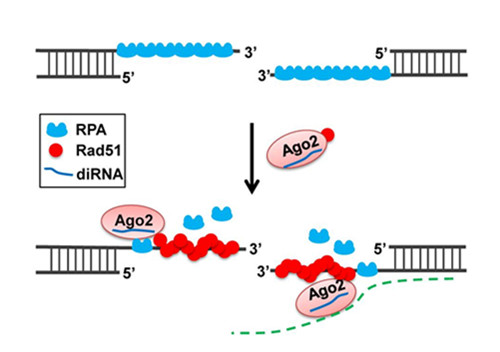
Ago2 Facilitates Rad51 Recruitment and DNA Double-strand Break Repair
Mar 28, 2014 Email"> PrintText Size

Recently, the lab of Prof. YANG Yungui from Beijing Institute of Genomics, Chinese Academy of Sciences (BIG), in collaboration with Prof. QI Yijun from School of Life Sciences, Tsinghua University, revealed that Ago2 facilitates Rad51 recruitment and DNA double-strand break repair by homologous recombination.
DNA double-strand breaks (DSBs) are highly cytotoxic lesions and pose a major threat to genome stability if not properly repaired. Scientists have previously shown that a class of DSB-induced small RNAs (diRNAs) is produced from sequences around DSB sites [Cell 149:101-112(2012), Cell 2012 Best-Paper]. DiRNAs are associated with Argonaute (Ago) proteins and play an important role in DSB repair, though the mechanism through which they act remains unclear.
Researchers reported that the role of diRNAs in DSB repair is restricted to repair by homologous recombination (HR) and that it specifically relies on the effector protein Ago2 in mammalian cells. Interestingly, they showed that Ago2 forms a complex with Rad51 and that the interaction is enhanced in cells treated with ionizing radiation.
Then, scientists demonstrated that Rad51 accumulation at DSB sites and HR repair depend on catalytic activity as well as small RNA binding capability of Ago2. In contrast, DSB resection as well as RPA and Mre11 loading is unaffected by Ago2 or Dicer depletion, suggesting that Ago2 very likely functions directly to mediate Rad51 accumulation.
Taken together, this study suggests that guided by diRNAs, Ago2 promotes Rad51 recruitment and/or retention at DSBs to facilitate repair by HR.
This research is supported by CAS, Ministry of Science and Technology and Natural Science Foundation of China. The work has published online in Cell Research.

Ago2-Rad51 complexes may be recruited to DNA DSB site through base pairing between diRNAs and homologous DNA sequences surrounding the break site or scaffold RNA transcripts (Green dashed line) generated from around the break site (Image by BIG)
Recently, the lab of Prof. YANG Yungui from Beijing Institute of Genomics, Chinese Academy of Sciences (BIG), in collaboration with Prof. QI Yijun from School of Life Sciences, Tsinghua University, revealed that Ago2 facilitates Rad51 recruitment and DNA double-strand break repair by homologous recombination.
DNA double-strand breaks (DSBs) are highly cytotoxic lesions and pose a major threat to genome stability if not properly repaired. Scientists have previously shown that a class of DSB-induced small RNAs (diRNAs) is produced from sequences around DSB sites [Cell 149:101-112(2012), Cell 2012 Best-Paper]. DiRNAs are associated with Argonaute (Ago) proteins and play an important role in DSB repair, though the mechanism through which they act remains unclear.
Researchers reported that the role of diRNAs in DSB repair is restricted to repair by homologous recombination (HR) and that it specifically relies on the effector protein Ago2 in mammalian cells. Interestingly, they showed that Ago2 forms a complex with Rad51 and that the interaction is enhanced in cells treated with ionizing radiation.
Then, scientists demonstrated that Rad51 accumulation at DSB sites and HR repair depend on catalytic activity as well as small RNA binding capability of Ago2. In contrast, DSB resection as well as RPA and Mre11 loading is unaffected by Ago2 or Dicer depletion, suggesting that Ago2 very likely functions directly to mediate Rad51 accumulation.
Taken together, this study suggests that guided by diRNAs, Ago2 promotes Rad51 recruitment and/or retention at DSBs to facilitate repair by HR.
This research is supported by CAS, Ministry of Science and Technology and Natural Science Foundation of China. The work has published online in Cell Research.

Ago2-Rad51 complexes may be recruited to DNA DSB site through base pairing between diRNAs and homologous DNA sequences surrounding the break site or scaffold RNA transcripts (Green dashed line) generated from around the break site (Image by BIG)
CAS Institutes
There are 124 Institutions directly under the CAS by the end of 2012, with 104 research institutes, five universities & supporting organizations, 12 management organizations that consist of the headquarters and branches, and three other units. Moreover, there are 25 legal entities affiliated and 22 CAS invested holding enterprisesThere are 124 I...>> more
Contact Us

Chinese Academy of Sciences
Add: 52 Sanlihe Rd., Xicheng District, Beijing, China
Postcode: 100864
Tel: 86-10-68597592 (day) 86-10-68597289 (night)
Fax: 86-10-68511095 (day) 86-10-68512458 (night)
E-mail: cas_en@cas.cn

